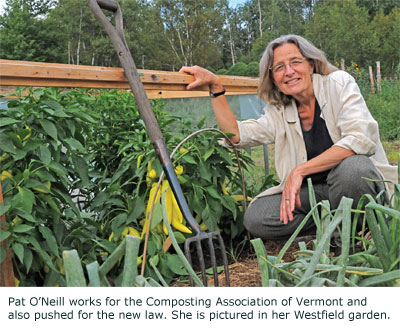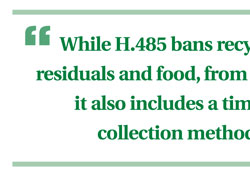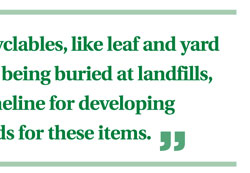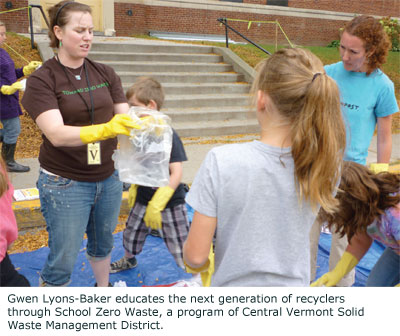

Waste not, Want Not : by Allison Teague - Photos by Jan Doerler |
||||
|
Solid waste may not sound like a women's issue to you, but when Vermont's H.485 was signed into law early in June, the number of women standing behind Gov. Peter Shumlin as he signed the bill was notable. Many had been involved in the long legislative process that led to this first-in-the-nation legislation to ban organic waste—meaning biodegradable waste from animals or plants—in landfills completely by 2020. The bold law, which represents the first major change in solid waste law in 25 years, went into effect in July. The first phase requires large-volume generators of food waste to recycle by 2014. Households will be required to recycle paper and plastic by 2015, all yard waste by 2016, and all organic matter by 2020. Vermont now recycles a bit more than one-third of its waste. Backers of the legislation say the new law will double the amount of material kept out of Vermont landfills. Much behind-the-scenes work is necessary to get any bill onto the governor's desk. By tradition, the pens used to sign a bill into law are given as gifts to recognize those who most helped passage. Jen Holliday of Chittenden Solid Waste District (CSWD) got one of two pens Shumlin gave out for H.485. She was the lead for state Waste Districts to move on the legislation as it went through the House and Senate, and manages a compliance and stewardship program at CSWD. "Ah, the pen," Holliday said in a recent email. "It is on a shelf in my office next to photos of my three kids and two awards I have received from other organizations. It was an honor to receive the pen. To me it symbolizes that my work, although frustrating at times, is worthwhile, and will make Vermont a better place to live. |
|||
On Her Way to the Dump "It's actually ironic that I would become so involved in waste management because as a child, I was deathly afraid of garbage trucks," Holliday explained. "I would not go outside of my house to play [when trash was being collected] because I was afraid that one of the garbage truck men would pick me up and throw me in the back of the truck." In spite of that fear, she said she comes from a "long line of 'garbage pickers.' My grandmother got chased off the dump regularly." Holliday recalls using wine glasses her grandmother found at the dump. "I am fascinated. I think trash tells a better story than anything about ourselves," she laughed. "I just see it as a real mirror of who we are. We can look at it [and see] who we are as a society." Her friend, Pat O'Neill of Westfield, a fellow advocate with the non-profit Composting Association of Vermont (CAV), was also significantly involved in the legislative process. She said the bill took a lot of "environmental work, working on solutions about recycling and composting." In particular, she said, it required educating policymakers and the public to see "recycling as a resource." O'Neill helped with policy work from the beginning. "It is part of the CAV mission, in terms of building a robust composting sector in Vermont, to work closely with solid waste districts and the Vermont Agency of Natural Resources (ANR)." Getting the bill passed was a "long, long process. It took five years to do the whole thing," said O'Neill. "There was a lot of work to do with towns, and then getting all the pieces in place." Some of the work, said O'Neill, was just "figuring out what was involved, and working with towns building consensus around where we wanted composting facilities in Vermont." Holliday agreed on the nature and importance of this groundwork. "Understanding local government challenges to get the public to recycle" was part of the research Jen Holliday she was involved in from the beginning. "[For municipalities to] afford to recycle, there needed to be a change in the system," she said. |
||||
Enforcing the New Bill Cathy Jamieson, solid waste program manager of the Vermont Waste Management and Prevention Division of the ANR, explained the gist of the bill and, because of its large vision and schedule, referred to the "ANR Cheat Sheet": "A significant portion of the waste stream … is composed of recyclable items, leaf and yard … and food residuals that could be diverted from landfills and put to better use," it noted. "Meanwhile, the landfill space in Vermont is limited and one of the two major landfills is nearing its capacity." Value in recyclable resources had been buried in landfills, Jamieson explains. "Now, post-H.485, resources can be redirected back into the community for significant added value for businesses, and for waste management districts and municipalities." While H.485 bans recyclables, like leaf and yard residuals and food, from being buried at landfills, it also includes a timeline for developing collection methods for these items, and specifies that this should occur at the same location where trash is currently collected. |
 |
|||
Recycling is proven to reduce energy consumption and greenhouse gas emissions. Mandating future composting and recycling will make materials more widely available for reuse. For instance, composting is a simple method for converting plant and animal waste into valuable fertilizer. More available recyclables will provide incentives for other investment opportunities. In the meantime, Jamieson said, "ANR will be conducting a thorough evaluation of present methods of collection and recycling, as well as ones needed to implement the requirements of this law by November 2013. We are looking at the full picture," she said, adding an assurance: "There is no provision that affects individuals right now." As for how Vermont women might rethink their kitchen food scraps in light of the new recycling bill, she suggested they begin "by reducing excess food through smart purchasing," and diverting valuable food to local food shelves and the Vermont Food Bank "for people who actually need it." "There are many options for diverting food scraps, including through a compost pile or bin," added Jamieson explained, "and there may be more options in the future." ANR's waste management site has information available for composting methods and the means for getting started. Environmental Futures Jen Holliday and Pat O'Neill are but two names frequently associated with the various aspects of recycling in Vermont. O'Neill works from home, and has been involved with the paint production stewardship bill, mercury hazardous waste and, most recently, H.485. "I was an early adopter of recycling and composting," she said. She grew up in a family that gardened, canned and "berry picked" on the New Jersey shore. When she moved to Vermont near Jay Peak, she was in the nursery business for 10 years. When she had children, her views "definitely tied into how I raised my family. My son was homeschooled, and the garden was a part of the classroom." "I think the larger picture is earth stewardship. How we take care of the soil impacts us. Increasing the organic matter in the soil allows soil to do its job better, percolating water, holding storm water and cleaning water," O'Neill said. Holliday sees an even larger purpose in paying attention. "For most people, they put their trash in a can at home, and never think twice. For me it's a story. It tells who we are, from an environmental and cultural perspective." Her background and education in environmental science and chemistry lay the foundation for her current work, she said. Gwen Lyons-Baker, School Zero waste coordinator for Central Vermont Solid Waste Management District, located in Montpelier, tends to agree with Holliday on the socio-anthropological perspective of trash. One of her regular projects, carried out in the 28 schools in her district, is a "waste audit." "We dump a day's worth of trash out on a big tarp, and go through it, and examine with the kids what people are throwing away," she explains. "They also consider what can be reused, recycled or composted." In general, the kids are "excited." Lyons-Baker also thinks that having a female instructor in this non-traditional field of waste management "gives younger girls something to look up to." "In some schools, we run a composting program," she said. "At one of my schools, I have five girls all year long who volunteer for tracking trash or emptying food buckets." Lyons-Baker is a UVM graduate in environmental education. "I was involved in more outdoor environmental education at nature centers and so forth," she said about her previous work. "I have always felt strongly about educating the next generation." |
||||
 |
 |
Why So Many Women in Waste? Leesa Stewart is general manager of the Central Vermont Solid Waste Management District, where six women hold key positions. She came from 20 years of working in the non-profit sector for environmental groups such as the Vermont Public Interest Research Group (VPIRG), because "I saw the public sector as a source for solutions," she says. |
||
She says that many of the women she works with in waste management, especially "on the programming end …came on board because of a strong interest in environmental issues, wanting to do something positive and productive in the environmental sector." "My mother's family is from South Glens Falls, NY, near Fort Edward, which was the home of General Electric (GE)," Stewart noted. At the time, GE was dumping toxic PCBs in the Hudson River, "and it's now a Superfund site. I came from seeing what havoc can be wreaked on the environment." She added, "There's a lot of cancer in the region." |
||||
Barb Baird, who works with Stewart as administrative coordinator and district clerk, does not think that the proliferation of women in management positions in solid waste is necessarily based on sex. "Women are doing anything for work now, and might be attracted to any position in a municipality," she said. "Some might be looking for environmental work, or be looking for a structured municipality job." Any stable municipality with a charter might make for an attractive workplace. Cathie Jamieson, ANR's solid waste program manager of the Vermont Waste Management & Prevention Division, ventured that perhaps "it's the nurturing of the earth aspect" that draws women to this work with recycling, composting and reusing. Stewart also sees the work as "doing good for the community, and keeping it healthy with appropriate waste management. With two kids, you certainly want to build a better world for children, and preserve it, and set an example for them. You lead and teach by example," she noted. Jamieson agrees, saying, "I have 25 years in the Department of Environmental Conservation, and have an interest in making sure we are using resources sustainably, preserving resources for the future." She continued, "I certainly think both women and men should be concerned about how we sustainably use the earth and resources." |
 |
|||
Lyons-Baker does not have children, but noted, "Women nurture and have children, and thus, are very conscious of the environment their child grows up in. We want a healthy environment." |
||||
Writer Allison Teague grew up in northern Vermont, lived on the West Coast and Alaska for 20 years, and now pursues writing and art from her cabin in southern Vermont. For the first time in 30 years, she boasts running water and indoor plumbing. |
||||